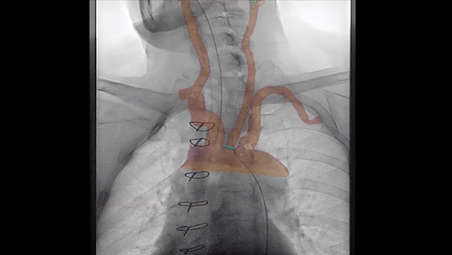- 3D image fusion
-
3D image fusion in endovascular procedures
Studies¹,² have shown the advantages of a 3D perspective for catheter and device guidance. With VesselNavigator, clinicians can easily segment 3D vessel structures from existing CT/MR datasets and fuse them with live X-ray for guidance. - Reduction in contrast usage
-
Reduction in contrast usage
Average contrast medium usage was reduced by 72% in a study[1] that used Philips CTA image fusion guidance during endovascular repair of complex aortic aneurysms. No intraprocedural contrast agent injection was required to create a roadmap. - Potential to reduce procedure time
-
Potential to reduce procedure time
Philips CTA Image Fusion Guidance may lead to shorter procedure times. A study of 62 patients² showed an average reduction in procedure time from 6.3 to 5.2 hours during FEVAR/BEVAR procedures using Philips CTA image fusion guidance. - Moves in sync to new positions
-
Moves in sync to new positions
During the procedure, VesselNavigator provides a real-time overlay that moves in sync with any projection, table and system position. This can reduce the need to make additional contrast enhanced runs to create new roadmaps. - Superb image quality
-
Superb image quality
Create overlays based on a variety of superb volume rendering visualization options. These can be customized according to user preferences. - Anatomical
-
Anatomical ring markers
Ring markers can be added to the segmented image to indicate the ostia and landing zone and to define planning angles. These markers are visualized during the procedure for guidance.
3D image fusion in endovascular procedures

3D image fusion in endovascular procedures

3D image fusion in endovascular procedures
Reduction in contrast usage

Reduction in contrast usage

Reduction in contrast usage
Potential to reduce procedure time

Potential to reduce procedure time

Potential to reduce procedure time
Moves in sync to new positions

Moves in sync to new positions

Moves in sync to new positions
Superb image quality

Superb image quality

Superb image quality
Anatomical ring markers

Anatomical ring markers

Anatomical ring markers
- 3D image fusion
- Reduction in contrast usage
- Potential to reduce procedure time
- Moves in sync to new positions
- 3D image fusion
-
3D image fusion in endovascular procedures
Studies¹,² have shown the advantages of a 3D perspective for catheter and device guidance. With VesselNavigator, clinicians can easily segment 3D vessel structures from existing CT/MR datasets and fuse them with live X-ray for guidance. - Reduction in contrast usage
-
Reduction in contrast usage
Average contrast medium usage was reduced by 72% in a study[1] that used Philips CTA image fusion guidance during endovascular repair of complex aortic aneurysms. No intraprocedural contrast agent injection was required to create a roadmap. - Potential to reduce procedure time
-
Potential to reduce procedure time
Philips CTA Image Fusion Guidance may lead to shorter procedure times. A study of 62 patients² showed an average reduction in procedure time from 6.3 to 5.2 hours during FEVAR/BEVAR procedures using Philips CTA image fusion guidance. - Moves in sync to new positions
-
Moves in sync to new positions
During the procedure, VesselNavigator provides a real-time overlay that moves in sync with any projection, table and system position. This can reduce the need to make additional contrast enhanced runs to create new roadmaps. - Superb image quality
-
Superb image quality
Create overlays based on a variety of superb volume rendering visualization options. These can be customized according to user preferences. - Anatomical
-
Anatomical ring markers
Ring markers can be added to the segmented image to indicate the ostia and landing zone and to define planning angles. These markers are visualized during the procedure for guidance.
3D image fusion in endovascular procedures

3D image fusion in endovascular procedures

3D image fusion in endovascular procedures
Reduction in contrast usage

Reduction in contrast usage

Reduction in contrast usage
Potential to reduce procedure time

Potential to reduce procedure time

Potential to reduce procedure time
Moves in sync to new positions

Moves in sync to new positions

Moves in sync to new positions
Superb image quality

Superb image quality

Superb image quality
Anatomical ring markers

Anatomical ring markers

Anatomical ring markers
Related products
Alternative products
-
Azurion 7 M20
- Image Guided Therapy System Monoplane Ceiling/Floor Mounted with a 20" flat detector
- Enhance visibility for diverse vascular, oncology and cardiac procedures with great image quality
- Control all relevant applications via the central touch screen module at table side
Vezi produsul
-
XperGuide
- Needle navigation technology with CBCT for accurate reach of lesions as small as 1 cm or below
- Supports procedures from biopsies and drainages to radiofrequency ablations
- Six times less needle repositioning compared to conventional CT
- 29% less skin dose compared to conventional CT
Vezi produsul
-
Azurion 7 M20
Experience outstanding interventional cardiac and vascular performance on the Azurion 7 Series with 20'' flat detector. This industry leading image-guided therapy solution supports you in delivering outstanding patient care and increasing your operational efficiency by uniting clinical excellence with workflow innovation. Seamlessly control all relevant applications from a single touch screen at table side, to help make fast, informed decisions in the sterile field.
Vezi produsul
-
XperGuide
XperGuide offers live 3D image needle guidance, letting you bring percutaneous needle procedures into the interventional lab. It overlays live fluoroscopy and 3D soft tissue imaging data from previously-acquired CT or MR scans or Philips XperCT, providing information on the needle path and target.
Vezi produsul
- 1. Tacher V, et al (2013). Image Guidance for Endovascular Repair of Complex Aortic Aneurysms: Comparison of Two-dimensional and Three-dimensional Angiography and Image Fusion, J Vasc Interv Radiol, 24(11), 1698-1706. http://www.ncbi.nlm.nih.gov/pubmed/24035418
- 2. Sailer AM, et al (2014). CTA with fluoroscopy image fusion guidance in endovascular complex aortic aneurysm repair, Eur J Vasc Endovasc Surg. 2014 Apr;47(4):349-56. http://www.ncbi.nlm.nih.gov/pubmed/24485850


